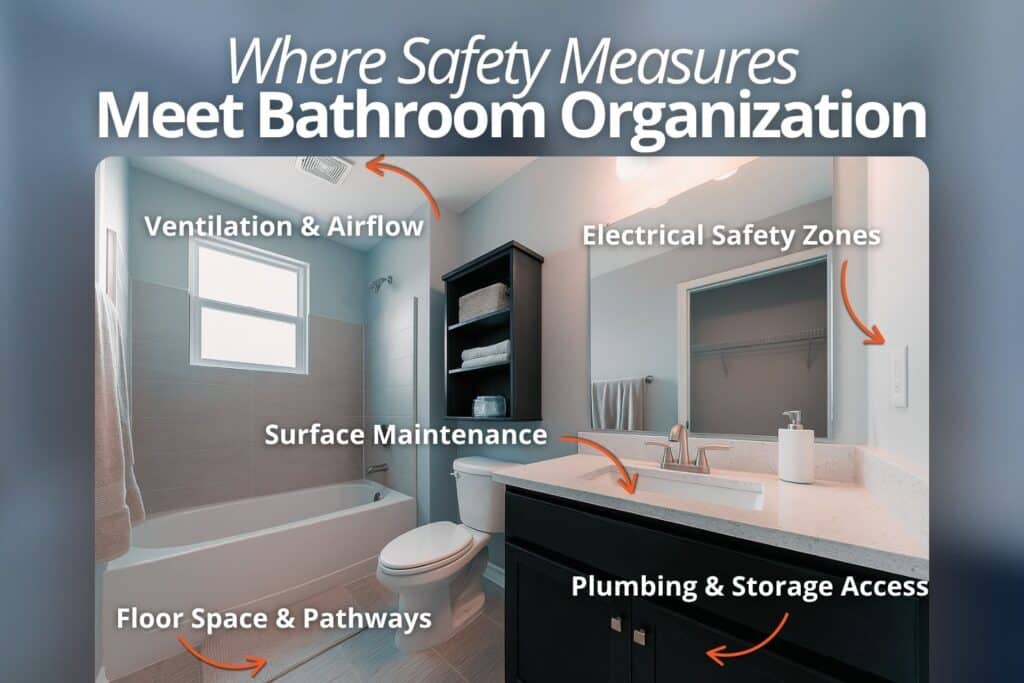Most homeowners think of bathroom organization as a design choice, but it plays a direct role in safety. An unorganized bathroom increases the risk of slips, falls, and hidden water damage. It can also make it harder to spot problems during an inspection.
Around 235,000 people are injured in bathroom accidents every year, and over 80% of those injuries come from falls. A few small organizational changes can make a big difference in preventing hazards, reducing moisture, and keeping your home’s most-used space in good condition.
Let’s look at how organization and safety intersect, what Centex Inspection Services often finds in disorganized bathrooms across Central Texas, and how you can create a safer layout for your home.
Table of Contents
ToggleHow Bathroom Organization Affects Safety
Bathrooms combine three risk factors: water, electricity, and tight spaces. When the area becomes cluttered or poorly ventilated, it’s more likely to lead to safety and maintenance issues.
Inspectors at Centex regularly find that disorganized bathrooms cause:
- Blocked airflow that traps humidity and encourages mold growth
- Hidden leaks under sinks or around tubs
- Loose rugs or crowded floors that increase fall risk
- Unsafe outlet placement or overused extension cords
- Limited visibility that makes cleaning and inspections harder
Improving the bathroom’s organization means addressing these components from the start…
1) Safer Bathroom Layout
A smart layout gives you both comfort and safety. It helps prevent accidents while keeping maintenance simple.
Keep Pathways Clear
Walkways between the sink, shower, and toilet should remain open. Avoid placing baskets, laundry bins, or small furniture in these zones.
Mind the Floor
Slippery surfaces are one of the most common safety issues inspectors note. Use non-slip mats that grip the floor securely. Avoid layering rugs or placing decorative mats near wet zones.
Think About Reachability
Items used daily, like towels or hair dryers, should be within arm’s reach but away from water. Keep frequently used items in drawers or shelves near eye level to avoid stretching or bending.

Quick Reference: Safe Layout Guide
| Layout Area | Common Problem | Safer Solution |
| Sink Area | Cluttered counters | Use vertical shelving or drawer organizers |
| Toilet Area | Items behind or above the tank falling | Items behind or above the tank are falling |
| Shower Area | Bottles scattered on ledges | Add wall-mounted caddies or corner shelves |
| Entryway | Small rugs that slide | Replace with rubber-backed mats |
These organizational improvements make the bathroom easier to use, and also prevent common injuries or inspection flags.
2) Plan Storage with Safety in Mind
Proper storage can reduce clutter, extend the life of your fixtures, and support better air circulation.
Keep Heavy Items Low
Store cleaners, bulk supplies, and large bottles on lower shelves or in under-sink cabinets. Heavy items stored high can fall and cause injury.
Use Clear Containers
Transparent bins make it easier to see what you have and prevent overbuying products that lead to clutter. Label bins by category, such as cleaning, first aid, or grooming, to make upkeep simple.
Avoid Overloading Shelves
When shelving starts to bow or tilt, it becomes unstable. Limit heavy storage and evenly distribute weight.
Anchor Tall Cabinets
Freestanding storage towers and tall organizers should be secured to the wall. This reduces the risk of tipping, especially in small spaces where people move around quickly.
Pro Tip: Inspectors at Centex often note blocked access to plumbing shutoff valves and outlets. Keeping these areas free of clutter makes maintenance faster and safer.
3) Improve Airflow and Control Moisture
Humidity is one of the biggest problems inspectors see in Central Texas bathrooms. Without proper ventilation, even well-built bathrooms can develop mold and mildew.
Keep Vents Clear
Avoid blocking exhaust vents or air returns with storage bins, baskets, or wall décor. Obstructed vents trap moisture and make ventilation ineffective.
Use the Fan Correctly
Run the ventilation fan during and for at least 20 minutes after showers to help keep humidity between 30% and 50%, which the EPA identifies as the optimal range for preventing mold.
Store Items for Air Circulation
Avoid stacking towels and products tightly in closed cabinets. Use breathable baskets or open shelving when possible.
Check for Early Signs of Moisture Damage
Keeping humidity under control extends the lifespan of your finishes and reduces future repair costs. Here are some tips…
| Warning Sign | Possible Cause | Action |
| Musty smell | Trapped moisture or mold | Run the fan longer and clean vents |
| Peeling paint | Run the fan longer and clean the vents | Repaint with moisture-resistant paint |
| Rust around fixtures | Poor ventilation | Check fan operation and airflow |
| Condensation on mirrors | Weak air circulation | Increase ventilation time |
4) Electrical and Lighting Safety
The room’s organization directly affects how safely electrical systems function in the bathroom.
Install GFCI Outlets
Ground Fault Circuit Interrupter (GFCI) outlets are required in bathrooms. They shut off power if they detect an imbalance, preventing electrical shock.
Avoid Outlet Overload
If you use multiple grooming tools or chargers, rotate them instead of using adapters or extension cords. These cords create tripping hazards and fire risks when placed near sinks or wet counters.
Proper Lighting
Dim lighting increases fall risk and hides water on the floor. Replace yellow bulbs with bright, cool-toned LEDs that mimic daylight.
According to the U.S. Dept of Energy, LED lighting can reduce energy use by up to 75% compared to incandescent bulbs while providing better visibility.
Cord Organization
Mount wall hooks or use cable clips to keep cords tidy. Cords should never hang across wet counters or near tubs.
5) Declutter for Easier Maintenance and Inspection
An organized bathroom allows for faster, more accurate inspections. When inspectors can access pipes, outlets, and ventilation grilles easily, they’re able to detect problems that homeowners might miss.
Keep Plumbing Accessible
Avoid stacking supplies under sinks where pipes run. If a leak starts, clutter delays discovery and can worsen water damage.
Rotate Cleaning Products
Use older supplies first and discard duplicates. Excess cleaning chemicals increase clutter and can corrode shelving over time.
Check Hidden Corners
Pull bins out once a month to look for drips, rust, or mold. A few minutes of upkeep prevents bigger problems.
Label Emergency Valves
Mark your water shutoff valves clearly. In a plumbing emergency, easy access can prevent major flooding.
Quick Maintenance Checklist
| Task | Frequency | Purpose |
| Wipe down shelves and baskets | Weekly | Prevent mold and residue |
| Inspect under sinks for leaks | Monthly | Detect early plumbing issues |
| Clean the exhaust fan cover | Every 3 months | Maintain airflow efficiency |
| Reorganize drawers and bins | Every 6 months | Prevent clutter and damage |
A consistent routine like this keeps your space safe, efficient, and easy to inspect.

Simple Upgrades That Blend Safety and Style
Small updates can make your bathroom look better while improving safety.
- Wall-mounted shelving keeps floors open and easier to clean.
- Grab bars disguised as towel holders provide stability without looking industrial.
- Textured tile or vinyl flooring reduces slip risk and adds modern appeal.
- Soft-close drawers prevent pinched fingers and extend hardware life.
- Motion-sensor lights improve visibility for nighttime use.
These upgrades are affordable and boost both appearance and practicality. They’re also features that Centex Inspection Services sees in homes that maintain excellent long-term safety and function.
Related Questions Homeowners Ask
Can poor organization hide inspection issues?
Yes. Clutter can block airflow, hide water stains, or prevent access to plumbing and electrical components. Keeping spaces clear helps inspectors find and document problems accurately.
Does organization affect resale value?
Indirectly, yes. A tidy and safe bathroom signals care and maintenance to potential buyers. It can also reduce repair recommendations during a pre-listing inspection.
Should I organize before or after an inspection?
Organizing before makes the inspection more thorough and allows you to address concerns sooner.
When to Call a Professional
If you start to see musty smells, soft flooring, bubbling paint, or outlets that trip often, these may be early signs of moisture or electrical concerns developing behind the walls.
This is the time to contact Centex Inspection Services. Our experienced team provides detailed bathroom and whole-home inspections across Central Texas, identifying potential risks before they become costly repairs.
During an inspection, we evaluate areas that homeowners often overlook, including ventilation efficiency, hidden plumbing lines, and subfloor moisture levels.
A professional inspection is especially worth scheduling if:
- You’ve completed a renovation or installed new fixtures.
- You’re preparing to sell your home and want to avoid unexpected findings.
- You notice consistent humidity, mildew spots, or peeling paint.
- Your bathroom is over ten years old and has not been inspected recently.
By calling Centex Inspection Services, you ensure your bathroom stays on track with both organization and safety, protecting your investment and giving you confidence every step of the way.
Conclusion
Bathroom organization influences more than convenience. It protects your family and your home. By keeping the layout safe, improving airflow, and maintaining clutter-free surfaces, you reduce accident risks and make inspections smoother.
For expert insight into how your home systems are performing, contact Centex Inspection Services to schedule a professional inspection in Central Texas. A well-organized, safe bathroom is a smart investment in both comfort and peace of mind.




